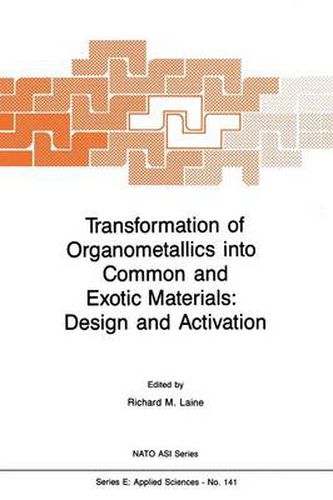Readings Newsletter
Become a Readings Member to make your shopping experience even easier.
Sign in or sign up for free!
You’re not far away from qualifying for FREE standard shipping within Australia
You’ve qualified for FREE standard shipping within Australia
The cart is loading…






This title is printed to order. This book may have been self-published. If so, we cannot guarantee the quality of the content. In the main most books will have gone through the editing process however some may not. We therefore suggest that you be aware of this before ordering this book. If in doubt check either the author or publisher’s details as we are unable to accept any returns unless they are faulty. Please contact us if you have any questions.
The design, -synthesis, and selective pyrolytic conversion of organo metallic precursdrs to materials of high purity or specific morphology (for electronic or optical applications), high strength and/or high-temperature stability (for structural or refractory applications) represents a poten tial area of extreme growth at the overlap of chemistry and materials science (materials chemistry). Research in this area is likely to have considerable impact at both the academic and societal levels because it will require development of scientific expertise in areas currently not well understood. Examples include: (1) The thermodynamics of molecular rearrangements in organometallic molecules at temperatures above 200 DegreesC; (2) The electronic properties of amorphous ceramic materials; (3) The phys icochemical properties of ceramic molecular composites; and (4) The optical properties of multicomponent glasses made by sol-gel processing. The opportunity to establish the scientific principles needed to pursue useful research goals in materials chemistry requires communica tion between chemists, ceramists, metallurgists, and physicists. To date, there have been few opportunities to create an environment where such communication might occur. The objective of this NATO Advanced Research Workshop was to promote discussions between experts in the varibus disci plines aligned with materials chemistry.
These discussions were intended to identify the scope and potential rewards of research efforts in the development of: Custom-designed precursors to common and exotic materials, methods of selectively transforming these precursors in high yield to the desired material, and methods of characterizing the final products.
$9.00 standard shipping within Australia
FREE standard shipping within Australia for orders over $100.00
Express & International shipping calculated at checkout
This title is printed to order. This book may have been self-published. If so, we cannot guarantee the quality of the content. In the main most books will have gone through the editing process however some may not. We therefore suggest that you be aware of this before ordering this book. If in doubt check either the author or publisher’s details as we are unable to accept any returns unless they are faulty. Please contact us if you have any questions.
The design, -synthesis, and selective pyrolytic conversion of organo metallic precursdrs to materials of high purity or specific morphology (for electronic or optical applications), high strength and/or high-temperature stability (for structural or refractory applications) represents a poten tial area of extreme growth at the overlap of chemistry and materials science (materials chemistry). Research in this area is likely to have considerable impact at both the academic and societal levels because it will require development of scientific expertise in areas currently not well understood. Examples include: (1) The thermodynamics of molecular rearrangements in organometallic molecules at temperatures above 200 DegreesC; (2) The electronic properties of amorphous ceramic materials; (3) The phys icochemical properties of ceramic molecular composites; and (4) The optical properties of multicomponent glasses made by sol-gel processing. The opportunity to establish the scientific principles needed to pursue useful research goals in materials chemistry requires communica tion between chemists, ceramists, metallurgists, and physicists. To date, there have been few opportunities to create an environment where such communication might occur. The objective of this NATO Advanced Research Workshop was to promote discussions between experts in the varibus disci plines aligned with materials chemistry.
These discussions were intended to identify the scope and potential rewards of research efforts in the development of: Custom-designed precursors to common and exotic materials, methods of selectively transforming these precursors in high yield to the desired material, and methods of characterizing the final products.